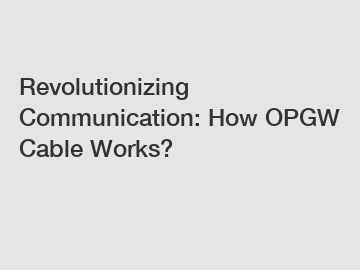Mar. 26, 2024
If you are looking for more details, kindly visit huaneng.
### Understanding OPGW Cable.
OPGW (Optical Ground Wire) cable is a type of cable that revolutionizes communication by combining the functions of a ground wire and a fiber optic cable. This innovative design allows for both power transmission and data communication in a single cable, making it an essential component in modern communication networks.

### Step 1: Construction of OPGW Cable.
OPGW cable is constructed using a central stainless steel tube that houses the fiber optic strands. The tube is surrounded by layers of aluminum wires and stainless steel wires, providing structural support and electrical grounding. The entire assembly is then encased in a weather-resistant outer layer to protect the fibers from environmental factors.
### Step 2: Power Transmission.
The OPGW cable functions as a conventional ground wire in power transmission lines, providing a path for electric current to flow safely to the ground in the event of a fault. The aluminum and steel wires surrounding the fiber optic tube carry the electrical current, ensuring the stability and reliability of the power grid.
### Step 3: Data Communication.
Featured content:In addition to its role in power transmission, the fiber optic strands within the OPGW cable enable high-speed data communication. Light signals are sent through the optical fibers, carrying information over long distances with minimal loss or interference. This allows for the transmission of voice, video, and data signals for various communication applications.
### Step 4: Benefits of OPGW Cable.
The integration of power transmission and data communication in a single cable offers several advantages. OPGW cables help reduce the number of cables needed in utility infrastructure, saving space and simplifying installation. The use of fiber optics also increases the bandwidth and reliability of communication networks, improving overall performance.
### Step 5: Applications of OPGW Cable.
OPGW cables are commonly used in overhead power transmission lines, providing a cost-effective solution for combining power and communication needs. They are also used in areas where traditional communication infrastructure is impractical, such as remote or rural locations. OPGW cables play a crucial role in enhancing the efficiency and reliability of modern communication systems.
In conclusion, OPGW cable revolutionizes communication by integrating power transmission and data communication in a single, efficient solution. By understanding how OPGW cable works and its benefits, we can appreciate its significance in modern communication networks.
Please visit our website for more information on this topic.
The company is the world’s best plastic spiral vibration damper supplier. We are your one-stop shop for all needs. Our staff are highly-specialized and will help you find the product you need.
Featured content:Previous: Everything You Need to Know About Joint Boxes for OPGW Installation
Next: None
If you are interested in sending in a Guest Blogger Submission,welcome to write for us!
All Comments ( 0 )